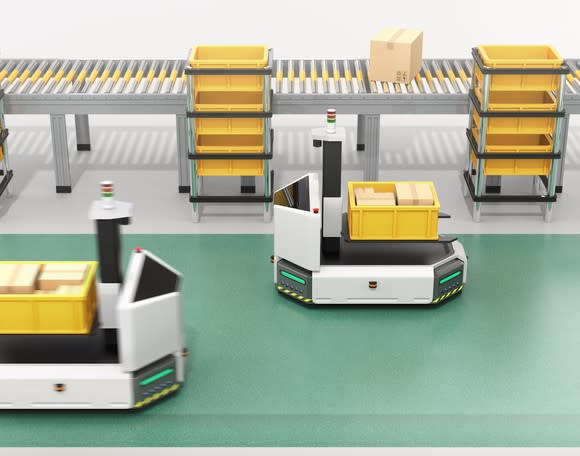Will Small, Robot-Run Warehouses Change the Grocery Game?
Robots already play a fairly large role in e-commerce. Amazon, for example, had an army of 45,000 robots as of 2016 that selected and packed orders in its fulfillment centers, and as of this spring, that number had grown to more than 100,000.
Amazon's fulfillment centers, however, are huge -- many of them well in excess of 1 million square feet. That's natural for a chain handling the volume of orders it does, and other major digital retailers globally have built similarly massive warehouses, according to a 2015 Wall Street Journal article (subscription required). And when dealing with scale that large, automating whatever a company can makes sense.
By contrast, grocery chains looking to move orders to customers within relatively small geographic areas work at far smaller scales. These retailers have generally employed good old-fashioned humans to pull together the orders that come in online, either for delivery or in-store pickup -- because for them, people remain more cost-effective than machines.
New technologies are emerging that may change that calculus, however. A number of start-ups are developing "micro-fulfillment centers" -- heavily automated operations in the 6,000- to 10,000-square-foot range that can be placed within or adjacent to traditional grocery stores.

Micro-fulfillment centers use mostly automated workers. Image source: Getty Images.
What is micro-fulfillment?
One of the emerging players in the space, Takeoff Technologies, is designing a system that will allow customers to order groceries online, then pick them up as soon as half an hour later. Supermarket chains that partner with the company will house its automated digital fulfillment centers within their existing local stores, rather than using remote warehouses a la Amazon.
Takeoff's system will "squeez[e] the extra space" out of the traditional grocery store, according to a video released by the company. It houses all the merchandise a store offers in about 10% of the space, "providing high-speed access to the products that customers need."
Essentially, Takeoff has created what looks a bit like a giant vending machine, where orders are gathered by robots. Once those orders are packaged, customers can pick up their purchases in store, or have them delivered to their homes or to other locations with secure pickup lockers.
"I believe this idea is the future of grocery retailing," Guizhou University of Finance and Economics Professor Gene Detroyer told RetailWire. "It provides the time saving and convenience that is the unstoppable trend of shoppers today and more so tomorrow."
Will this work?
It's pretty clear that the retail industry, including the grocery segment, will continue to increase its use of automation for quite some time. Having employees walk around a store to piece together customers' orders -- the way Instacart does it now -- is inefficient. The micro-fulfillment model allows grocery chains to deploy robotic efficiency effectively on a local level.
Another company trying to solve this puzzle, Israeli start-up CommonSense Robotics, has been testing a micro-fulfillment model in which one center would serve multiple nearby grocery stores, according to Supermarket News.
"The services the company provides include a micro fulfillment center and an automated packing system run by robots that get smarter over time by using artificial intelligence (AI)," wrote Gloria Dawson. "These fulfillment centers will operate in urban areas in basements or underutilized spaces as small as 10,000 square feet. They will be staffed by a handful of employees and a few hundred robots."
Actual deployment of these systems is likely a few years out, as it will require remodeling stores or building new ones with micro-fulfillment centers incorporated into them -- but the robots are coming to supermarket near you. Automating the picking-and-packing process will save time for consumers, and money for grocery chains -- and that's the kind of logic that corporate executives can't ignore.
More From The Motley Fool
John Mackey, CEO of Whole Foods Market, an Amazon subsidiary, is a member of The Motley Fool's board of directors. Daniel B. Kline has no position in any of the stocks mentioned. The Motley Fool owns shares of and recommends Amazon. The Motley Fool has a disclosure policy.

 Yahoo Finance
Yahoo Finance 